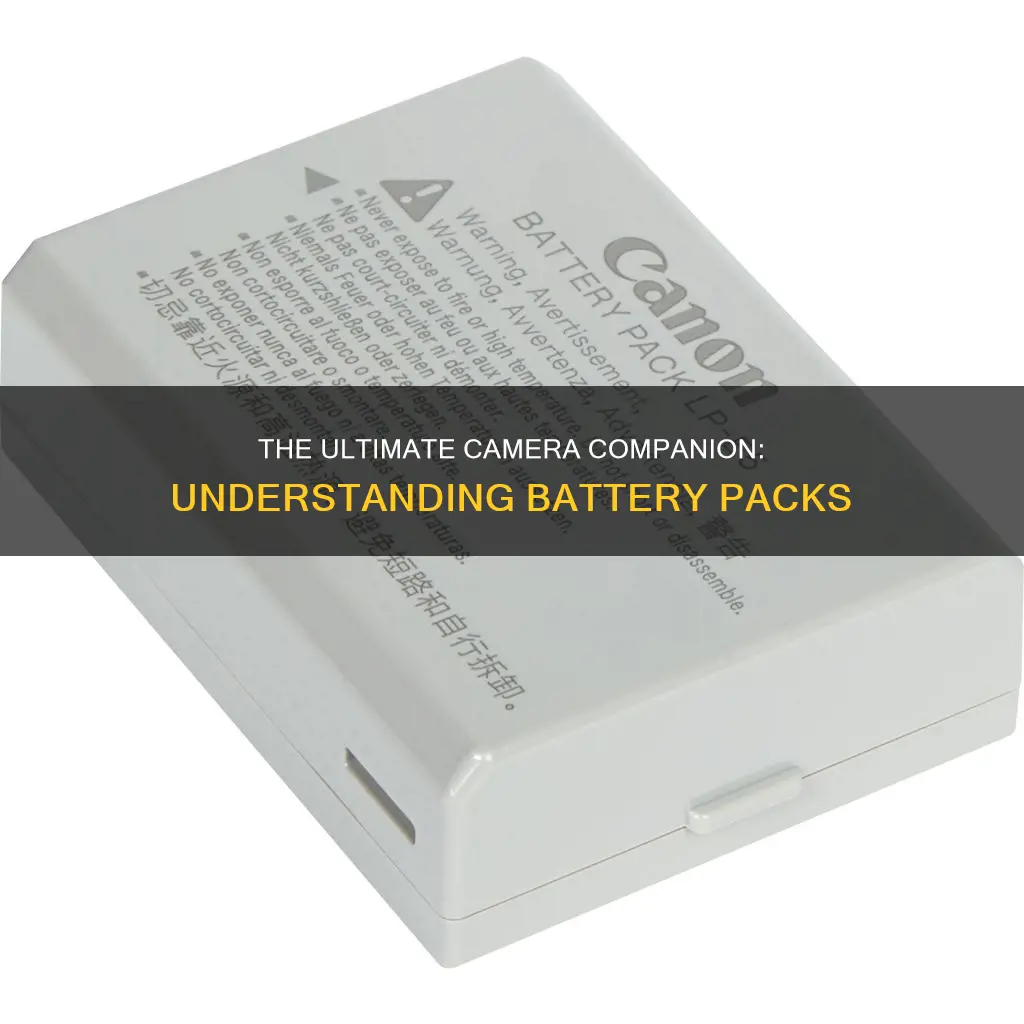
Camera battery packs are essential for photographers who want to ensure they never miss a shot due to a dead camera battery. These portable batteries come in various shapes and sizes, with different voltage and current requirements, so it's important to choose one that is compatible with your specific camera model. Some battery packs provide external power to cameras through dummy batteries, while others charge the camera's internal battery directly via a USB connection. Lithium-ion batteries are a common type used in camera battery packs, known for their ability to withstand constant charging and discharging without significant capacity degradation. When shopping for a camera battery pack, consider factors such as capacity, output speed, input current rating, durability, and price to find the best option for your needs.
Characteristics of a Camera Battery Pack
| Characteristics | Values |
|---|---|
| Purpose | Provide external power to cameras, especially when shooting video or in cold conditions |
| Compatibility | Specific to camera model and battery type |
| Battery Type | Often lithium-ion batteries |
| Charging | Best done via mains using a USB wall adapter |
| Charging Time | Faster input current rating leads to faster charging |
| Construction | Premium models have aluminium construction; cheaper models have polycarbonate finish |
| Weight | Heavier models have higher capacity |
What You'll Learn
- Camera battery packs can be used to recharge your camera on the go
- They are small, portable batteries that use li-ion battery chemistry
- Reputable brands build-in circuit protection to ensure safety and protect your camera
- Battery packs are designed to be carried around in a bag or pocket and used regularly
- When shopping for a battery pack, prioritise compatibility with your camera?

Camera battery packs can be used to recharge your camera on the go
Camera battery packs are a great way to ensure your camera stays charged when you're on the move. They are small, portable batteries that can be used to recharge your camera using a USB charging cable. Camera battery packs are especially useful if you're travelling or don't have easy access to a power source to recharge your camera.
Most camera battery packs use lithium-ion batteries, which allow for constant charging and discharging without degrading the battery's overall capacity or performance. When shopping for a camera battery pack, it's important to consider the capacity, output, input, and construction of the pack.
Capacity refers to the amount of charge the battery pack can hold, measured in mAh. A higher capacity will allow you to charge your camera multiple times before having to recharge the battery pack itself, but it will also make the device bigger and heavier. Output refers to the speed at which power is moved from the battery pack to the device, measured in amps. The average output speed is around 2.1 amps, but some battery packs are capable of faster speeds.
When it comes to input, the best way to recharge your battery pack is through a mains power source using a USB wall adapter that meets your battery pack's voltage and current requirements. Faster input current ratings will result in faster recharge times. Finally, consider the construction of the battery pack. Premium and flagship packs often feature rugged aluminium construction, while cheaper models typically have a polycarbonate finish.
By investing in a camera battery pack, you can ensure that your camera stays charged and ready to capture all the important moments, even when you're on the go.
How to Keep Date and Time Settings on Canon A560
You may want to see also

They are small, portable batteries that use li-ion battery chemistry
Camera battery packs are small, portable batteries that use li-ion battery chemistry. They are designed to power cameras and camera accessories, such as flash units. These battery packs are usually lightweight and easy to carry, making them convenient for photographers who are always on the go.
Li-ion batteries are commonly used in camera battery packs because they offer several advantages. One of the main benefits is their high energy density, which means they can store a large amount of energy in a small space. This makes them ideal for cameras, as they can provide a significant amount of power without adding excessive weight or bulk to the device.
Another advantage of li-ion batteries is their ability to hold a charge for a long period. They have a low self-discharge rate, which means they can retain their power even when not in use for extended periods. This makes them reliable and convenient for photographers who may not use their cameras for extended periods.
Additionally, li-ion batteries are rechargeable, which adds to their convenience and cost-effectiveness. Photographers can simply recharge the battery packs instead of constantly purchasing new ones. This also helps reduce waste and makes li-ion batteries more environmentally friendly than disposable options.
When using li-ion camera battery packs, it is important to follow proper care and maintenance practices. These batteries should be charged only as long as necessary to avoid overheating and potential damage. It is also crucial to store them in a safe place, as puncturing or damaging li-ion batteries can be hazardous.
In conclusion, camera battery packs that use li-ion battery chemistry offer photographers a portable, reliable, and rechargeable power source for their equipment. By understanding the benefits and proper care of these battery packs, photographers can ensure they have the power they need to capture memorable moments.
Charging Your Eufy Camera Battery: A Step-by-Step Guide
You may want to see also

Reputable brands build-in circuit protection to ensure safety and protect your camera
When shopping for a camera battery pack, it is important to consider reputable brands that build in circuit protection to ensure safety and protect your camera. While third-party batteries are often more affordable, they may be poorly made, prone to losing charge, and in the worst-case scenario, they could damage your camera. Reputable brands that build in circuit protection include Anker, Jackery, and RavPower.
Anker is one of the biggest players in the portable battery pack market. Their PowerCore+ range is their flagship battery pack, which includes five models with different power reserve capacities ranging from 3,350mAh to 26,800mAh. The PowerCore+ 10050, in particular, stands out for its small size, comfortable grip, and built-in technologies that maximize output to minimize charging time.
Jackery is another reputable brand known for its solidly built and nicely finished battery packs. Their Jackery Giant+ model offers a high power reserve of 12,000mAh, a stylish design, and the ability to charge two devices simultaneously.
RavPower offers a wide range of portable battery packs, from pocket-friendly 3,200mAh devices to larger 26,800mAh options. Their RavPower Triple iSmart 2.0 model is unique in that it features three iSmart 2.0 USB ports, allowing for simultaneous charging of up to three devices. It also includes Panasonic's Smart IC power management and nine other types of built-in protection to ensure safety against overheating, surge damage, and short circuits.
When choosing a camera battery pack, it is essential to prioritize compatibility, safety, and reliability. By opting for reputable brands with built-in circuit protection, you can ensure the safety of your devices and maximize the benefits of your camera battery pack.
How Long Do Camera Battery Chargers Last?
You may want to see also

Battery packs are designed to be carried around in a bag or pocket and used regularly
The Anker PowerCore+ 10050, for example, is a brilliant little battery pack that's small enough to fit in your pocket. It's constructed from premium-grade Panasonic battery cells and US-made electronics, and has a robust build quality and a premium matte aluminium finish.
The Jackery Giant+ is another well-made and durable device, with an aluminium outer casing and a polycarbonate finish on each end. It's bigger and heavier than the Anker PowerCore+ 10050, but it holds slightly more charge, which could be useful for tablet or other power-hungry users.
The Mophie Powerstation also comes in a range of models, with the entry-level Powerstation 1x, ideal for mobile phones, and the Powerstation 5x and 8x, which are geared towards tablet users. The 1x, 2x and 3x models are small enough to fit in your pocket, while the 3x, 5x and 8x models all have dual USB ports that allow you to charge two devices at the same time.
The Onadaptr Flip Power Dual USB Charger and Powerbank is an innovative device that serves as both a standard three-pin plug-to-USB adapter and a portable battery pack. While 2,000mAh of reserve power may not be a huge amount, it definitely adds to the overall functionality of the device.
Wireless Surveillance Cameras: How Long Do Batteries Really Last?
You may want to see also

When shopping for a battery pack, prioritise compatibility with your camera
When shopping for a battery pack, it is important to prioritise compatibility with your camera. Different cameras have different needs, even if they are from the same manufacturer. DSLR, point-and-shoot, and mirrorless cameras all require specific shapes and styles of batteries. Therefore, it is crucial to check the compatibility of the battery pack with your specific camera model.
To ensure compatibility, it is recommended to purchase batteries from reputable manufacturers, such as the camera's original manufacturer or well-known third-party brands. This reduces the risk of poor performance, frequent loss of charge, or potential damage to your camera.
Additionally, when shopping for a battery pack, consider the type of battery used in your camera. Many camera batteries are lithium-ion, which have specific transportation restrictions, such as not being allowed in checked luggage on planes.
By prioritising compatibility and considering the battery type, you can ensure that your new battery pack will work seamlessly with your camera, providing reliable power during your photography sessions.
Best Doorbell Cameras Without Monthly Fees
You may want to see also
Frequently asked questions
A camera battery pack is an external, portable power source for your camera. It can be used to extend the battery life of your camera, providing an alternative to your camera's internal battery.
Camera battery packs are useful if you're planning on taking photos for an extended period of time, especially if you're shooting video or using your camera in cold conditions, which can drain your battery quickly.
When shopping for a camera battery pack, consider the capacity, output, input, and construction of the pack. Look for a pack that meets your camera's voltage and current requirements, and consider the size and weight of the pack, as a higher capacity pack will be larger and heavier.







